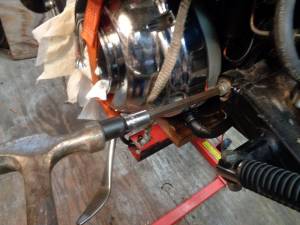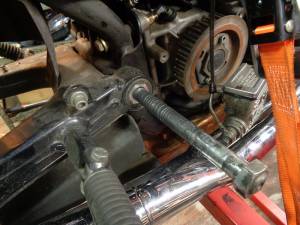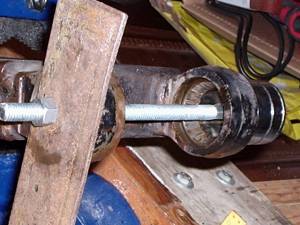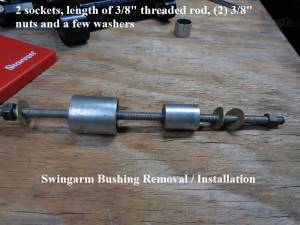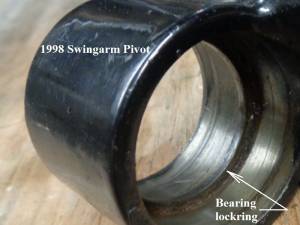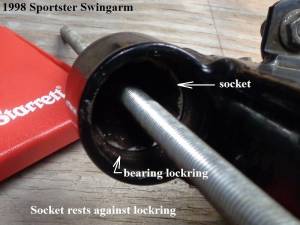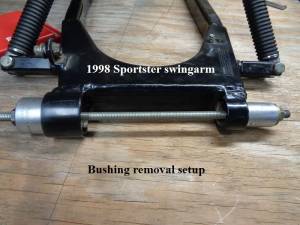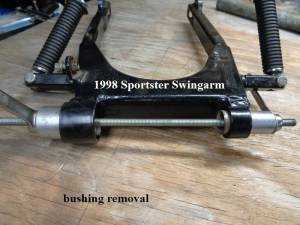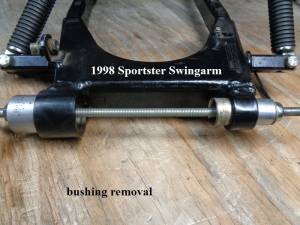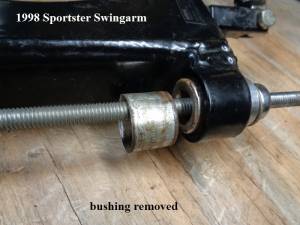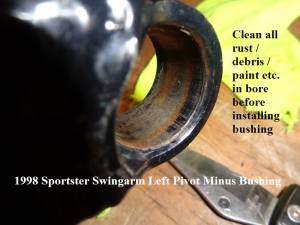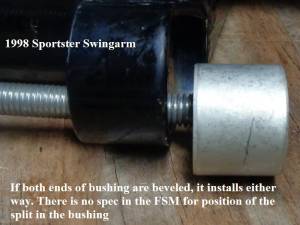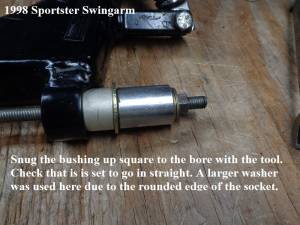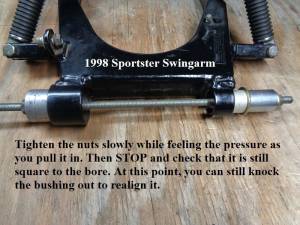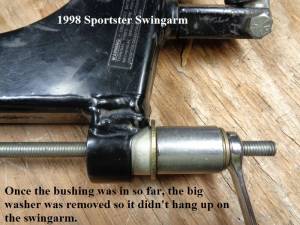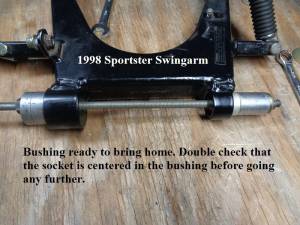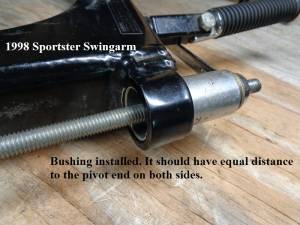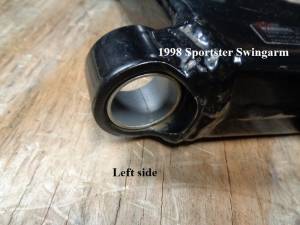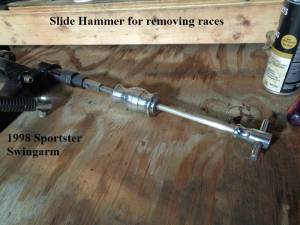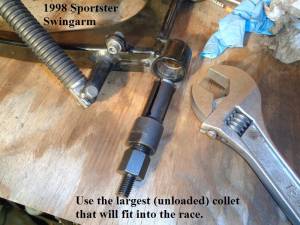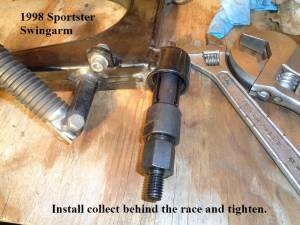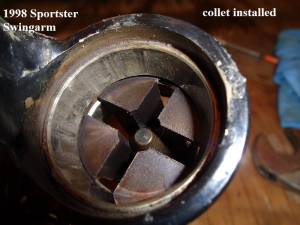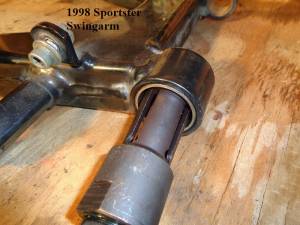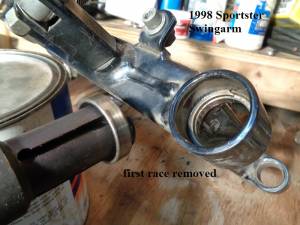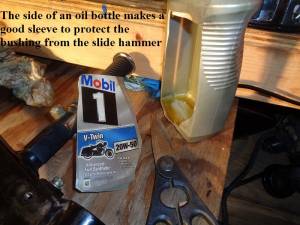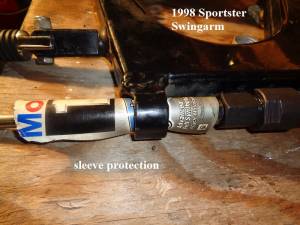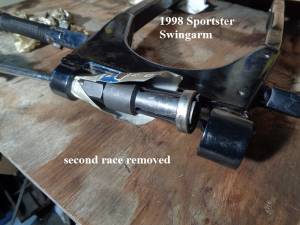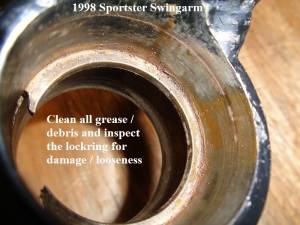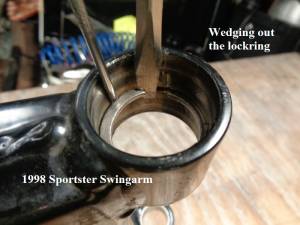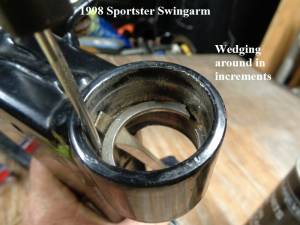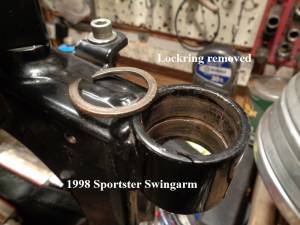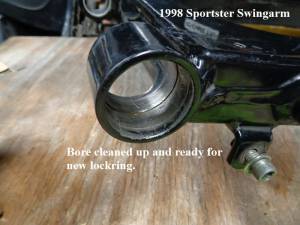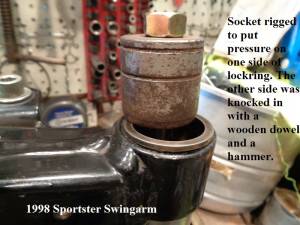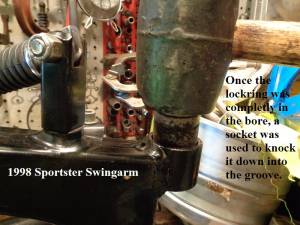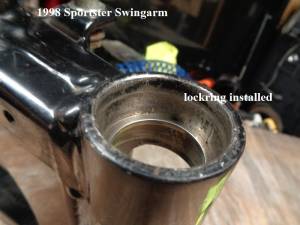Table of Contents
REF: Tools - 142
Swingarm Tools
IH Swingarm Thread Repair Tool
A wrecked right side bearing locknut 47515-52 [52 to E74] with a fitting welded into it.
Slots were cut into the threads and it is used to chase / repair the threads in the swingarm. 1)
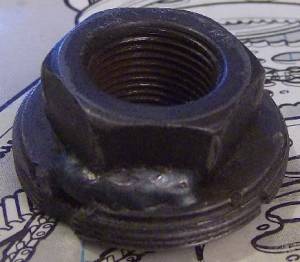 | 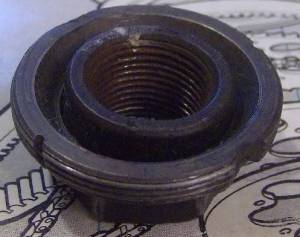 |
| Swingarm thread repair tool 2) | |
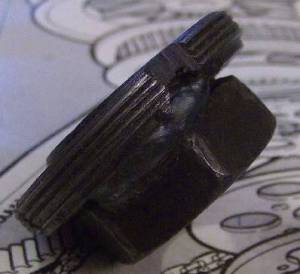 | 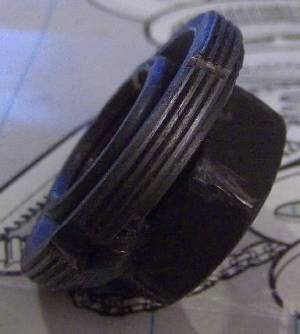 |
| Swingarm thread repair tool 3) | |
1993-2003 Pivot Bolt Wrench Sizes
To remove the pivot bolt, remove the pivot bolt screw and turn the bolt a few turns to loosen it up.
Put the pivot bolt screw back in a few turns and whack it with a hammer to initially drive it toward the right side.
Then use a screwdriver to pry the bolt out while turning the screw. Continue turning while giving up pressure on the wrench to back the bolt out.
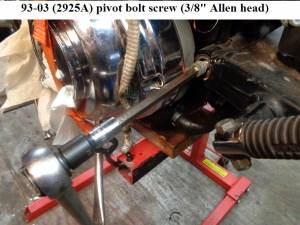 4)
4) 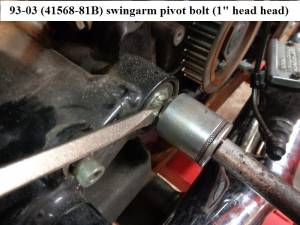 5)
5)
1982-2003 Swingarm
For 82-03 Sportsters with square tube swingarms.
Pivot Spacer Bushing
See also 1998 1200S Swingarm Bearing / Bushing Inspection and Replacement in the Sportsterpedia.
Use a socket or a flat piece of metal as a backing plate for installing / removing the bushing if the races are installed.
Removal
This method uses the lockring inside the pivot to push / pull against for pressing the bushing out and back in.
If the races are installed, simply use the outside pivot surface instead. The process is the same whichever bracing you use.
The FSM says to replace this bushing only if needed.
However, there is no criteria / spec to determine if it's needed. Use your best judgment.
If it's really in bad shape, you'll know it when you see it.
Also check for excess side play by rocking the spacer side to side in the bushing.
There are no clearance specs in the FSM for the spacer to bushing fit.
The bushing is pressed in and likewise will have to be pressed out. They make a special tool for removing / installing the bushing.
The rig below can also be used as a remover / installer tool.
- Parts:
- A length of 3/8“ threaded rod.
- (2)- 3/8” nuts and washers
- (2)- Sockets (you'll have to measure what you have on hand for proper fitment).
In this case, (1) 1-1/8“ and (1) 25/32” socket was used.- 1 has to either fit inside (outer races removed) or outside (outer races installed) of the right pivot.
The one used below was set against the bearing lockring in the middle of the right pivot.
Caution, do not use a socket on the inside if the races are installed. That could mar the internal bearing surface. - The other has to fit inside the right pivot and only a few thousandths (preferably) smaller than the bushing O.D.
Too small and it will mushroom the inside of the bushing.
Too big and it'll get stuck in the pivot.
Caution, measure to make sure it's smaller than the I.D. of the pivot before using it.
- (1) 1/2“ washer (optional).
Install the tool snug by hand and double check that the sockets are centered before tightening with a wrench.
Begin tightening and it will get hard to turn, then it'll eventually pop. It may sound like you just cracked the swingarm.
At any time, you can loosen / remove the tool and check the progress to make sure the socket isn't mushrooming the bushing instead of pushing it out.
It will probably be very tight will possible rust buildup and time.
But always keep in mind it may be tight because the socket got sideways and is now pulling against the pivot instead of the bushing. Double check if needed.
You can damage / crack the swingarm if this is not done properly.
It may 'pop' several times before it breaks free enough to pull out easy.
When this happens, pay attention to the bushing. You'll see it pull out more when you hear the pop.
Of course, the bushing may come out easily depending on what state it's in.
Just be aware of this so it doesn't surprise you. Keep turning the nut until the bushing slips out.
Then inspect the pivot bore for rust, pitting, cracks etc. Replace or repair the swingarm as needed.
Installation
Clean the pivot bore and the new bushing with solvent, acetone, brake cleaner etc.
It has to install dry with no grease in the bore on the bushing.
Install the bushing with the beveled end toward the bore. If both ends are beveled, it installs either way.
Line up the bushing square to the bore. The socket below had rounded edges which allowed it to kick sideways when torque was applied.
So a larger 1/2: washer was used to create the flat surface to initial pull in the bushing and keep it straight in the process.
Once you get the bushing snugged up by the tool, you can give that nut a sharp whack with a rubber hammer to 'set' the bushing face in the hole.
Then snug it back up, check for square and start pulling it in with the tool.
When you start tightening the tool, the nut will get hard to turn as the bushing gets squeezed into the bore.
But once it starts pulling in, the pressure should be consistent.
If the nut gets hard to turn all of a sudden, don't be afraid to remove the tool and check for obstructions and alignment.
Actually, a cheater bar was used on the wrench to pull the bushing in on the last 1/4” or so on this one.
Check to make sure the bushing wasn't damaged on installation.
Install the pivot bolt spacer to make sure it glides freely without bumps or stops.
The spacer is a slip fit and should not bind during operation. No reaming required.
Swingarm Races
Removal
A slide hammer can be used to remove the outer races.
You just need to make a sleeve to protect the pivot bushing when removing the inner race.
It is notable that this method can destroy the bushing if you're not careful.
Install the collect, thread the hammer and snatch until the race comes out. This may take quite a bit of effort, however.
Installation
The race has got to be straight before a regime of pounding or pressing to install it.
By far, the easiest way to start the race straight into the bore is to use a wood block or soft flat metal like aluminum to smack the race in straight.
If the race gets sideways, use a drift or screwdriver and knock it out with a hammer and 'reset' the race in straight.
Once it gets sideways don't try to smack it with a hammer to straighten it back up.
And don't believe, if using a press, you can keep applying pressure until it does straighten up.
You can ruin the bore that way.
Do not use any grease / lubricant to lube the bore to make it easier to install the race.
It is, by design, a press fit installation. That means the ID of the bore is the same OD of the race.
Grease does not make it easier to install the race. It makes it harder by adding thickness to the wall of the bore.
There are two races back to back and separated to a lock ring.
Grease will end up being push against the lock ring and the race won't go all the way home.
It's best to install one race at a time.
That way you only have to deal with one race getting sideways at a time.
Tools:
- Hammer and a wood block:
- You can use a wooden block on top of the race to initially to get it started in the bore.
Once started some, use the old race against the new one to pound it in.
But, if the race gets sideways while pounding, some will pound the high end down until the race is straight again.
While that is probably the fastest way to get the race in, it is not a good idea.
That wears against the side of the bore and can ruin the race surface.
- Bench vise:
- You can set the swingarm in a bench vise with a race against one side and the other side of the swingarm on the opposite jaw.
This works for some but it is easy to get the race sideways still and keep tightening the vise. - Some have opted to use a golf ball inside the race to press it in using a vise. This does work to a point (after the race was 'set' initially).
The golf ball widens however as pressure increases on the vise jaws and the race will pull in.
But due to the golf ball widening bigger than the pivot bore, you can not press the race home with it.
Then you still have to pound the race or press it in further to finish up.
- Threaded rod press:
- You can use a wood block and hammer to 'set' the race in the bore and then use some 3/8“ threaded rod and a couple sockets to press the race in.
This is probably the safest way to do it.
If the race gets sideways, the nuts get hard to turn. At that point, knock the race out and try again.
While tightening, the race will be a little difficult to turn but you can feel it pulling in.
If it gets hard all of a sudden, the race is either stuck sideways or it has made it home.
The socket needs to be slightly smaller than the OD of the race and preferably flat (not chamfered) on the edges. You can turn the socket around so the big open end is outboard with big washers for the nut to turn against.
| To start the race straight in the bore, use a hammer and a wooden block or soft aluminum block. 16) | |
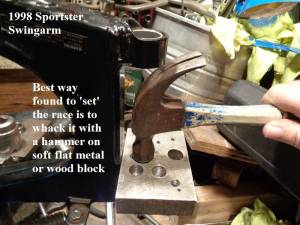 | 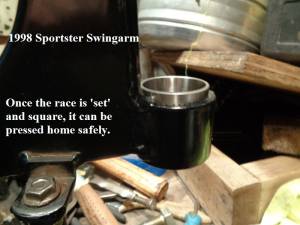 |
| Installing both races at the same time with a threaded rod. 17) | |
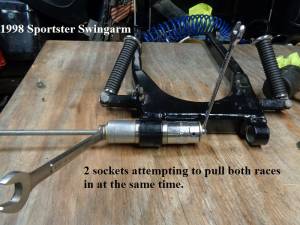 | 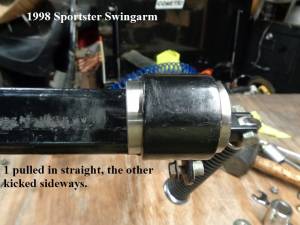 |
| Using a golf ball to pull the race in. 18) | ||
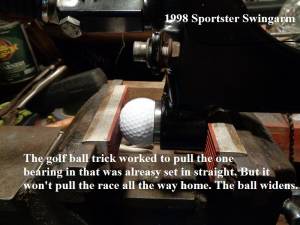 | 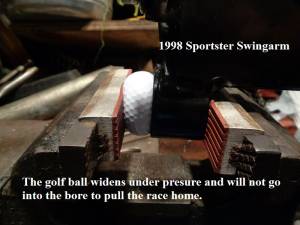 | 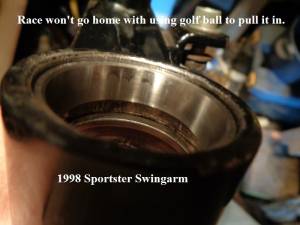 |
| Using a threaded 3/8” threaded rod and socket press. Both races can be pulled home with sockets on the races due to the lock ring in the middle. 19) |
||
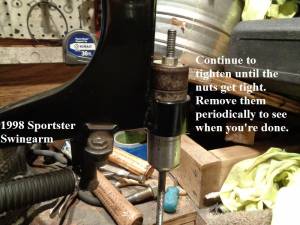 | 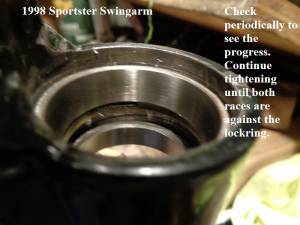 | 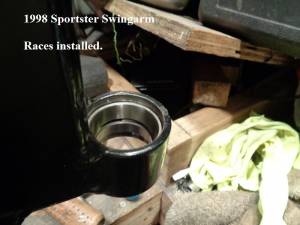 |
Bearing Lockring
Removal
Caution: Use eye protection as the lockring may pop out on you.
There is no reason to replace this ring unless it's damaged or rusted to the point it will hinder proper bearing race installation.
The races butt up against this ring on both sides and that determines distance apart from each other thus how far the inner bearing race sticks out the end.
So the races have to be installed correctly.
The ring can be used for both internal and external applications. However, the tool for these rings only works on external applications.
It pushes each end outward to expand the ring to remove it from shafts and the like.
There are no known pliers to compress the ring due to it having no holes or slots for pliers.
So it will need to be pried out with screwdrivers in a circle pattern to get the ring out of the groove in the pivot.
Once the ring is completely out of the groove, you can push it out of the pivot with a socket sized smaller than the pivot and near the same size as the ring.
Or it may just pop out on it's own. 20)
Installation
The ring needs to be installed with a tapered sleeve so you can set it in one side and knock it into the bore while the sleeve taper narrows the ID of the ring.
But without having that tool, a socket was bolted up into the bearing bore sitting on top of the open end of the ring to keep it from popping out.
Then the other side of the ring was carefully knocked into the bore with a wooden dowel and a hammer.
Once the ring was fully in the bore, the socket was used to push the ring down so it snapped into the groove. 21)

